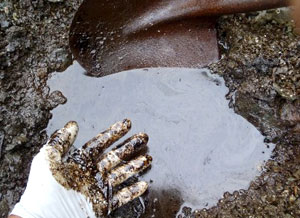Oil spills, pipeline ruptures, trains de-railing filled with oil – this is becoming a fact of life in the US as we increasingly lead the world on fossil fuel production.
Two technologies can potentially make it easier and much more effective to clean up the mess until we get our act together to get off fossil fuels.
Photocatalytic Nanogrid Technology
A scientist at SUNY/ Stony Brook has developed a simple technology that amazingly breaks down oil from a spill, leaving behind only biodegradable compounds.

"We have made a new catalyst that can break down hydrocarbons in water, and it does not contaminate the water," says Perena Gouma, who directs SUNY’s Center for Nanomaterials and Sensor Development.
She has developed a "nanogrid," which looks like a large fishing net and simply floats on the water. It consists of metal grids made of a copper tungsten oxide, that, when activated by sunlight, breaks oil down into biodegradable materials.
"It uses the whole solar spectrum and can work in water for a long time. When you shine light on these grids, they begin to work and can be used over and over again," she says. The key to how it works is the surface area formed by the metal grids – they provide maximum exposure to the contaminant to be remediated and the nanoscale particle sizes enable fast catalytic action," she explains.
They can be carried on ships and dropped into the water to neutralize spills, and the mats can similarly clean water that’s contaminated by fracking and from industrial processes.
And because they work well in water and air, they could be a chemical-free and possibly water-free, method of "dry cleaning" clothes in the future. Lay a net over your clothes, expose them to light, and you would no longer need a washing machine, chemicals, or even water.
She has two patents on the process and is in the process of creating a startup business that focuses on the fracking industry, where there are billions of tons of water to cleanup.
Incredibly, under the Obama Administration, we are pumping out 7.84 million barrels a day – 10% of world production, according to the US Energy Information Administration. This nano technology could make all the difference because with current archaic methods, such as laying out booms and dispersing the oil using toxic chemicals, only a tiny percentage of oil is recovered.
Drones for Oil Spills
Another technology doesn’t clean up spills, but predicts where they will flow and how far they will travel, making it more likely that precious ecosystems can be protected before it arrives there.
In Florida, researchers are testing drones and sensors to map ocean currents, according to an article in The Atlantic.
Scientists are mapping currents using a combination of drones flying overhead with cameras, 200 GPS-equipped "drifters," and sensors on the ocean’s surface and on the seabed track the movement of colored dye.
The data will be used to build a computer model of near-shore ocean currents that can predict how future oil spills or other pollutants will disperse as they approach the shore, says The Atlantic.
"Computer models will be able to give us better estimates of where the oil spill will go, and how fast and in which patterns it will spread," Tamay Özgökmen, who directs the Consortium for Advanced Research on Transport of Hydrocarbons in the Environment, told The Atlantic. "This can help emergency responders to better direct their limited resources. In the longer term, models are also helpful to make sense of any ecological damage that may have occurred in the environment."
Going forward, drifters and drones could be deployed over many square miles to track the movement of oil spills.
Modern Day Fossil Fuel Extraction
While it may seem there are endless supplies of oil and natural gas, the fact is easy access to extract fossil fuels is over. To get at it, companies are drilling in ever-more challenging conditions, such as miles down in the Gulf of Mexico, and potentially in the Arctic Ocean. Natural gas is booming only because of the new technology – fracking.
Another BP Deepwater Horizon disaster is imminent without greater regulation, reports Peter Moskowitz at Aljazeera.
"What we are talking about here is not an isolated event that happened four years ago on April 20 in the Gulf of Mexico," Najmedin Meshkati, a University of Southern California of civil and environmental engineering, told Aljazeera. "There is ultradeepwater drilling in the Black Sea in Turkey, deepwater drilling off the coast of Cuba, off the coast of Florida, in Alaska … BP was a wake-up call, but we put the wake-up call on snooze."
Some changes since the BP spill:
- The Bureau of Ocean Energy Management, Regulation and Enforcement has been split into two agencies, one that leases drilling rights and the other charged with protecting the environment (Bureau of Safety and Environmental Enforcement);
-
BP created a 24-hour offshore monitoring station in Houston, where engineers watch computer monitors to catch problems early on.
-
The oil and gas industry created the Center for Offshore Safety to share strategies for increasing drilling safety.
New regulations, though are sorely lacking and company culture continues to be focused more on profit than safety. Read the article:
